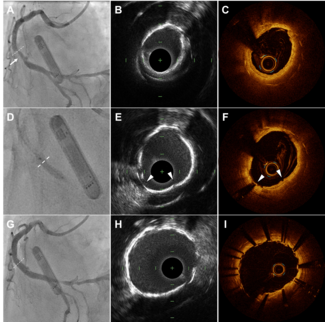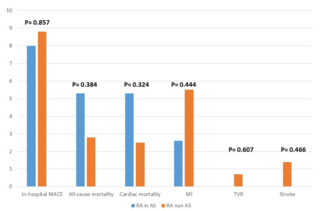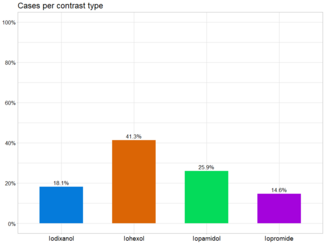Intervention of Stenosed Right Coronary Artery and Anomalous
Left Main Coronary Artery: Single Main Coronary Trunk
Case Report. An 86-year-old female with a medical history of hypertension and hypercholesterolemia who was on medication complained of dyspnea, chest pain and shortness of breath that was relieved at rest. She had a positive stress test and her electrocardiogram indicated sinus bradycardia, left anterior fascicular block and left ventricular hypertrophy. Her CK-MB and troponin I values were normal.
A computed tomography angiogram (CTA) revealed an anomalous left main (LM) artery originating from the right sinus of Valsalva coursing posteriorly with focal stenoses at the origin of the LM and right coronary (RCA) arteries (Figure 1A). Cardiac catheterization corroborated the CTA, revealing a 70% stenosed ostial RCA, 70% ostial, and 80% distal LM and coronary artery stenoses (Figure 1B). The patient had normal left ventricular function and no mitral or aortic stenosis.
Using a technique previously described by this group,1,2 the patient underwent successful percutaneous coronary intervention using simultaneous sirolimus-eluting kissing stents (SKS) of the anomalous ostial LM and ostial RCA (arrows). A 7 Fr internal mammary (IM) guide was used to engage the coronary ostium, and 2 Balance Middleweight (BMW) guidewires (Abbott Vascular Inc., Redwood City, California) were advanced, one into the right coronary artery (RCA) ostium and the other in the LM coronary ostium into the LAD. Next, 2 sirolimus-eluting stents (SES) (Cypher™, Cordis Corp., Miami Lakes, Florida) were advanced, one into the RCA and one in the LM ostium, using the technique described previously (Figure 1C). Additionally, 1 SES (3.0 x 13 mm) was deployed in the distal LM coronary artery. Final angiography after removal of the stent balloons and guidewire showed excellent results of both the RCA and LM ostia and the LM distal segment (Figure 1D), good stent expansion and no dissection.
The patient was discharged the following day and returned for a follow-up angiogram 8 months later, feeling well and revealing patent stents (Figure 1E).
Conclusion. Primary stenting of an anomalous LM artery has been documented;3 however, use of the SKS technique for anomalous bifurcating lesions has not yet been described. This SKS technique reduces in-hospital and 30- day major adverse cardiac events, decreases procedure time and lessens the need for target vessel revascularization at 9 months compared to a conventional technique of stenting the main vessel, balloon angioplasty and provisional stenting of the side branch.
References
1. Sharma SK, Choudhury A, Lee J, et al. Simultaneous kissing stents (SKS) technique for treating bifurcation lesions in medium-to-large size coronary arteries. Am J Cardiol 2004;94:913–917.
2. Sharma S. Simultaneous kissing drug-eluting stent technique for percutaneous treatment of bifurcation lesions in large–size vessels. Catheter Cardiovasc Interv 2005;65:10–16.
3. Nef HM, Möllmann H, Möllman S, et al. Primary stenting of the left main coronary artery with anomalous origin from the right Sinus of Valsalva. Int J Cardiol 2007;114:137–138.


















